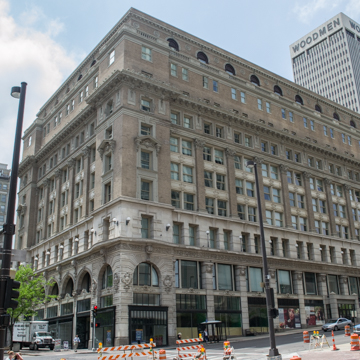You are here
Brandeis Building
Jonas L. Brandeis came to Omaha in 1881 and opened a small store known as The Fair. By the turn of the century Jonas’ sons had assumed responsibility for the business and began construction of what would be become the largest retail establishment in downtown Omaha. The design of the department store rivals such contemporaries as Macy’s in New York and Marshall Field’s in Chicago.
Occupying one half of a city block, this imposing landmark is a steel skeleton structure clad with brick, limestone, and terra-cotta. The first eight stories were completed in 1906; two floors were added in 1921 due to increasing business volume. The richly detailed facades reflect the Renaissance Revival style with each story articulated differently and separated by stringcourses of varying design. Cornices are supported with large modillions or consoles. Window trim and decorative details differ from floor to floor.
The front (east) elevation features arched openings at the base. Majestic fluted Corinthian columns, marble and terrazzo floors, and high ornate ceilings enhance the elegant interior of the first floor. The tenth floor originally housed restaurants with seating capacity of 1,500. The most elaborate was the Italian Renaissance Room, which featured gold leaf decorations, period replica chandeliers, and Wilton carpet.
Brandeis and his sons were retail innovators who created the region’s premier department store. They were one of the earliest retailers in Omaha to introduce sidewalk sales, elaborate window displays, and customer-oriented features like air conditioning and escalators. They were also the first mercantile establishment in the city to operate as a total service store with restaurants, a post office, and community meeting rooms.
The late 1950s brought typical modernization and expansion with the company building malls anchored by Brandeis stores. Eventually, the Omaha store was the headquarters of fifteen Midwest department stores in its chain. Brandeis peaked in the early 1970s and as retail business continued to move to the suburbs, the downtown store closed in 1980.
In the following years the building accommodated a variety of modestly successful commercial and residential ventures, each of which resulted in internal alterations. By the mid-2000s the building was only partially occupied after a redevelopment project went bankrupt. In 2008 the Kansas City developer Townsend Inc. purchased the Brandeis and undertook an ambitious project to convert the building for residential and commercial mixed-use. Work included restoring the facade, clearing accumulated debris from the entire building, and remodeling the interior. The lowest floor contains commercial space, offices, and a refurbished food court; the remaining floors house high-end rental apartments and condominiums. The Brandeis renovation, completed in 2009, contributed significantly to the development of new residences and new commercial vitality in downtown Omaha.
References
McCusker, Thomas J., and Fred M. Greguras, “J. L. Brandeis and Sons Store Building,” Douglas County, Nebraska. National Register of Historic Places Inventory-Nomination Form, 1982. National Park Service, U.S. Department of the Interior, Washington, DC.
Writing Credits
If SAH Archipedia has been useful to you, please consider supporting it.
SAH Archipedia tells the story of the United States through its buildings, landscapes, and cities. This freely available resource empowers the public with authoritative knowledge that deepens their understanding and appreciation of the built environment. But the Society of Architectural Historians, which created SAH Archipedia with University of Virginia Press, needs your support to maintain the high-caliber research, writing, photography, cartography, editing, design, and programming that make SAH Archipedia a trusted online resource available to all who value the history of place, heritage tourism, and learning.




